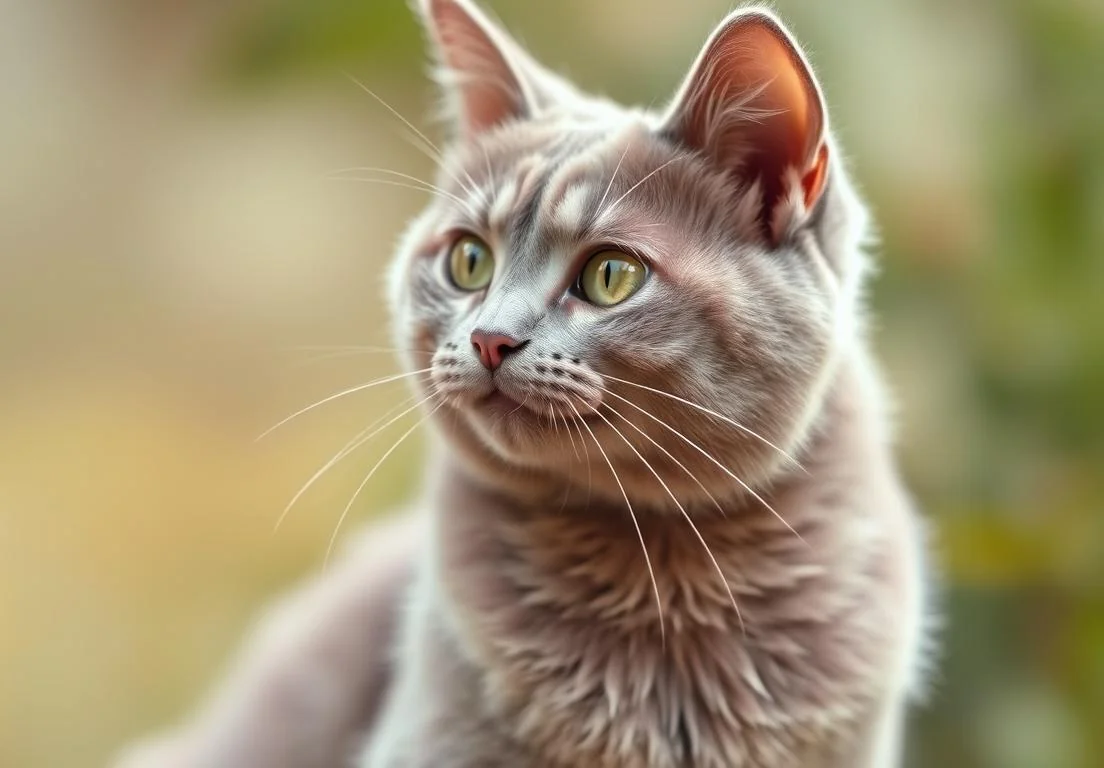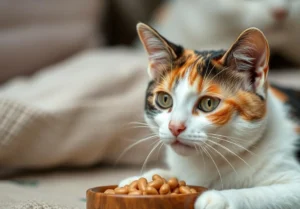Cranberries might be a staple in your Thanksgiving dinner, but what about your feline friend? You may wonder if these tart berries are safe for your cat.
Cranberries are not toxic to cats, but they should be given with caution. While they can offer some health benefits, too many can upset their stomach or lead to digestive issues. There’s deeper insight to this topic, including the potential pros and cons that every cat owner should be aware of!

What Happens If a Cat Eats Cranberries?
Cranberries aren’t toxic to cats, but that doesn’t mean they’re always a great idea.
Cranberries are generally safe for cats to consume in moderation, as they are not toxic according to major pet poison control centers and veterinary organizations (1, 2). They can offer some nutritional benefits, including vitamins A, C, and K, as well as antioxidants. However, cranberries should not replace a cat’s main diet, which is primarily carnivorous. It’s important to introduce cranberries carefully.
If a cat munches on cranberries, you might see a range of responses. Some cats may simply show mild interest while others could experience an upset stomach, leading to vomiting or diarrhea. This reaction is often due to the fruit’s acidity and fiber content, which can be tough for their digestive systems to handle.
Pay attention, especially if it’s a significant amount. If your cat seems fine, they might just be a little curious, but should they show any signs of distress, it’s wise to consult your vet. It’s worth noting that fresh cranberries are less likely to cause issues compared to processed forms like cranberry sauce or juice, which often have added sugars and other ingredients that aren’t good for cats.
Are Cranberries Safe for Cats?
Cranberries can be safe in moderation, offering some nutritional benefits. They’re a source of vitamins C and E, which can help support your cat’s immune system. However, not every feline will appreciate the taste or the tartness, and some may refuse to even take a nibble.
Interestingly, cranberries are sometimes recommended for their potential urinary tract health benefits (discussed below).
Still, if you’re contemplating cranberries as a snack for your cat, it’s best to chop them up small. This makes it easier for them to digest, and you can keep an eye on how they handle it.
In summary, while cats can eat cranberries, they should be given sparingly and observed for any negative reactions. If you notice your cat becoming ill or uncomfortable, it’s time to rethink those fruit treats.
What Nutrients Do Cranberries Provide?
Cranberries are not just a tart snack; they pack a nutritional punch too. For cats, cranberries offer vitamins such as C and E, which are crucial for maintaining a healthy immune system.
The antioxidants found in cranberries can help combat oxidative stress, promoting overall wellness. Plus, these berries are rich in fiber, aiding digestive health and supporting a healthy gut.
It’s essential to note that while cranberries contain flavonoids and polyphenols, which can be beneficial in preventing cellular damage, cats are obligate carnivores. This means their primary nutritional needs are met through animal-based sources. Nevertheless, occasional cranberry treats can contribute to a balanced diet.
Can Cranberries Help with Urinary Tract Health?
Cranberries are often celebrated for their potential benefits in urinary tract health. Cranberries contain proanthocyanidins, which may help prevent bacteria from adhering to the bladder wall, potentially reducing the risk of urinary tract infections (UTIs).
Urinary tract health benefits?
Some studies suggest that they might help deter bacteria from adhering to the urinary tract walls, though this research primarily focuses on humans and dogs. Consider the mechanisms of how cranberries affect urinary health. Cranberries contain proanthocyanidins, which are compounds believed to prevent E. coli bacteria from adhering to the bladder wall. This anti-adhesion property can help prevent urinary tract infections (UTIs) by reducing the likelihood of bacterial colonization. Consider how bacteria typically adhere to surfaces to establish infections; if they cannot stick, they are more likely to be flushed out. Source: Science Daily
While this property is widely recognized in humans, it also applies to our feline friends. Including small amounts of cranberries in your cat’s diet can be a proactive measure for urinary health, especially for cats prone to urinary tract issues. Just monitor how your cat reacts to them.
As you consider introducing cranberries, keep these practical tips in mind:
- Start Slow: Introduce cranberries gradually and observe for any signs of digestive upset.
- Fresh or Dried: Opt for fresh or unsweetened dried cranberries. Avoid cranberry juice or sweetened versions, as they can contain added sugars that aren’t suitable for cats.
- Limit Amounts: Just a pinch or two is sufficient. Too much can lead to stomach upset due to their acidity.
Always consult with your veterinarian before making any changes to your cat’s diet, especially when incorporating new foods like cranberries.
What Symptoms Indicate an Allergic Reaction?
Cats can be sensitive little creatures. If cranberries don’t sit well with them, it’s important to spot those allergic reactions early. Common symptoms include:
- Itchiness: If your cat is scratching, biting, or licking more than usual, they may be reacting to cranberries.
- Digestive issues: Watch for diarrhea, vomiting, or excessive gas. These could signal that cranberries are upsetting their tummy.
- Swelling: Any noticeable swelling, especially around the face or paws, should raise a red flag.
- Respiratory problems: Difficulty breathing or wheezing can indicate a serious allergy.
Difficulty breathing or wheezing in cats can be associated with allergic bronchitis, a condition resulting from an allergic reaction to airborne particles like pollen, dust, or smoke. This condition can lead to serious respiratory symptoms such as coughing and respiratory distress. It is essential for cat owners to seek veterinary care if their cat exhibits these symptoms, as they can indicate a serious health concern requiring immediate attention. For more detailed information on recognizing and managing allergies in cats, you can visit UrgentVet’s guide on allergies in cats.
If you notice any of these signs after introducing cranberries, it’s best to stop feeding them immediately and consult your vet.
If a cat exhibits symptoms such as itchiness, digestive issues, swelling, or respiratory problems after consuming cranberries, the best practice is to remove cranberries from their diet. This is based on the principle that introducing new foods should be done cautiously, and any adverse reactions necessitate an immediate halt and consultation with a veterinarian to ensure the cat’s health and safety. For example, if a cat starts scratching and has diarrhea after eating cranberries, stopping the introduction of that food is a responsible action to prevent further discomfort or potential health risks.
How to Introduce Cranberries to Your Cat’s Diet?
Cranberries can be a nutrient-rich snack for cats if introduced correctly. Start small—offer a tiny piece or a few drops of cranberry juice to see how your cat reacts.
Here’s a simple approach:
-
Pick fresh or pure : Choose fresh cranberries or unsweetened juice. Avoid anything with added sugars or preservatives.
-
Preparation : Chop fresh cranberries into small bits. Cooking them lightly can soften their texture, making them easier for your cat to manage.
-
Mix with food : Add a tiny amount to their regular food. Mixing helps mask unfamiliar tastes and makes it easier for them to adjust.
-
Observe : After the first introduction, keep an eye on your cat for a day or two. If there are no adverse reactions, you can gradually increase the amount, but keep it modest—cranberries should only make up a small part of their diet.
While cranberries have health benefits, remember they’re not essential for your cat’s diet. Always prioritize a balanced diet designed for felines, and treat cranberries as an occasional delight.
Are There Alternatives to Cranberries?
Cranberries might not be the best fruit option for cats, but luckily, there are plenty of safe alternatives that can still pack a nutritional punch.
Blueberries are a fantastic choice—these little berries are high in antioxidants and vitamins and your cat might enjoy their sweet-tart flavor. Another option is apples, which should be served without seeds and in small, manageable pieces. Apples provide fiber and vitamins and can be a fresh treat.
Pumpkin isn’t exactly a fruit, but it’s worth mentioning. It’s excellent for digestive health and is often well-tolerated by cats. Just be sure it’s pure pumpkin, not the spiced pie filling. Finally, consider bananas—though not every cat will like the taste, the potassium and fiber can be beneficial.
Offering these alternatives can keep snack time interesting while providing health benefits without the concerns that come with cranberries.
What Recent Research Says About Cranberries and Pets?
Recent studies around cranberries and pet health have stirred up some conversation. Research has shown that cranberries might have antimicrobial properties, especially in preventing urinary tract infections in dogs, but the findings for cats are less definitive.
Cats are obligate carnivores, which means their primary nutrition comes from animal sources, making their need for fruits like cranberries quite different from that of dogs. While some veterinary sources suggest that small amounts of cranberries could potentially aid in urinary health, it’s crucial to approach this with caution. Cats can have difficulty metabolizing certain compounds in cranberries, which might lead to upset stomachs or other digestive issues.
A study published in a veterinary journal even indicated that high levels of cranberry ingestion could lead to health concerns in cats. It’s always best to consult with a vet before introducing new foods, especially fruits like cranberries, to ensure they fit into your cat’s diet safely and healthily.
For more detailed insights, you can check resources like the American Veterinary Medical Association.
Alex, a passionate animal lover, has experience in training and understanding animal behavior. As a proud pet parent to two dogs and three cats, he founded AnimalReport.net to share insights from animal experts and expand his knowledge of the animal kingdom.




